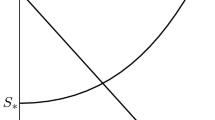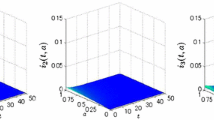Abstract
This paper considers an SIRS epidemic model that incorporates constant immigration rate, a general population-size dependent contact rate and proportional transfer rate from the infective class to susceptible class. A threshold parameter σ is identified. If σ⩽1, the diseasefree equilibrium is globally stable. If σ>1, a unique endemic equilibrium is locally asymptotically stable. For two important special cases of mass action incidence and standard incidence, global stability of the endemic equilibrium is proved provided the threshold is larger than unity. Some previous results are extended and improved.
Similar content being viewed by others
References
Brauer, F., Van Den Driessche, P., Models for transmission of disease with immigration of infectives, Math. Biosci., 2001,171:143–154.
Chen Junjie, Zhang Nansong, An HIV/AIDS transmission model with infectious stages and constant recruitment, Acta Math. Appl. Sinica—Chinese series, 2002, 25(3):538–546 (in Chinese).
Zhang Juan, Ma Zhien, Dynamic behavior of the SEIS model with saturating contact rate, J. Xian Jiaotong Univ., 2002,36(2):204–207.
Zhou Jinshi, An epidemiological model with population size dependent incidence, Rocky Mountain J. Math., 1994,24:429–445.
Roberts, M. G., Kao, R. R., The dynamics of an infectious disease in a population with birth pulses, Math. Biosci., 1998,149:23–36.
Greenhalgh, D., Hopf bifurcation in epidemic models with a latent period and nonpermanent immunity, Math. Comput. Modelling, 1997,25(2):85–107.
Thieme, H. R., Persistence under relaxed point-dissipativity (with application to an endemic model), SIAM J. Math. Anal., 1993,24(2):407–435.
Wang Fujun, Two epidemic models with emigration of population, Appl. Math. J. Chinese Univ. Ser. A, 1991,6(2):297–303.
Hethcote, H. W., Qualitative analyses of communicable disease models, Math. Biosci., 1976,28:335–356.
Mena-Lorca, J., Hethcote, H. W., Dynamic models of infectious diseases as regulators of population sizes, J. Math. Biol., 1992,30:693–716.
Liao Xiaoxin, Theory Methods and Application of Stability, Wuhan: Huazhong Science and Engineering University Press, 1999.
Gao Weibing, An Introduction to Dynamical Stability, Beijing:Higher Education Press, 1987.
Jeffries, C., Klee, V., Van Den Driessche, P., When is a matrix sign stable? Canad. J. Math., 1977,29:315–326.
Busenberg, S., Van Den Driessche, P., Analysis of a disease transmission model in a population with varying size, J. Math. Biol., 1990,28:257–270.
Genik, L., Van Den Driessche, P., A model for diseases without immunity in a variable size population, Canadian Appl. Math. Quart., 1998,6(1):5–16.
Fan Meng, Li Michael Y, Wang Ke, Global stability of an SEIS epidemic model with recruitment and a varying total population size, Math. Biosci., 2001,170:199–208.
Author information
Authors and Affiliations
Additional information
Supported by the Science and Technology Foundation of Zhejiang University (107000-544301).
Rights and permissions
About this article
Cite this article
Chen, J. An SIRS epidemic model. Appl. Math. Chin. Univ. 19, 101–108 (2004). https://doi.org/10.1007/s11766-004-0027-8
Received:
Issue Date:
DOI: https://doi.org/10.1007/s11766-004-0027-8




